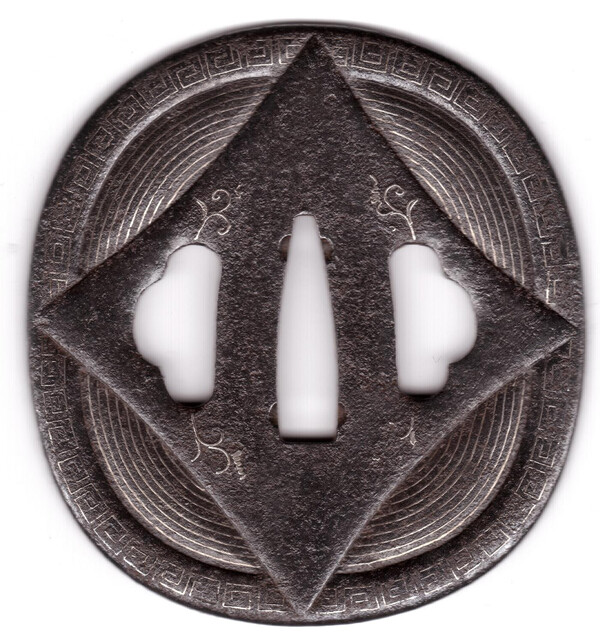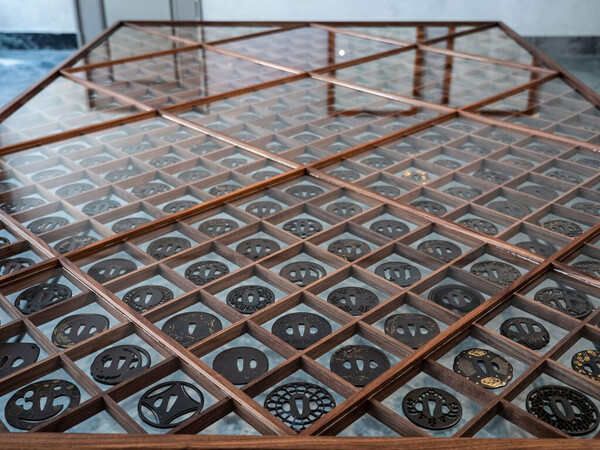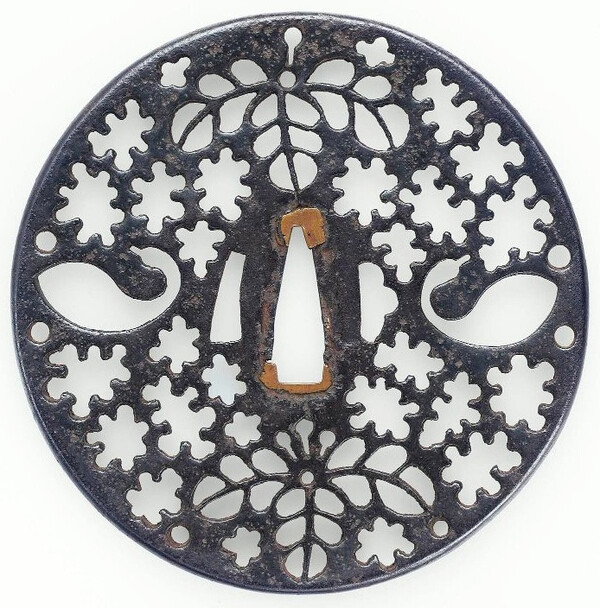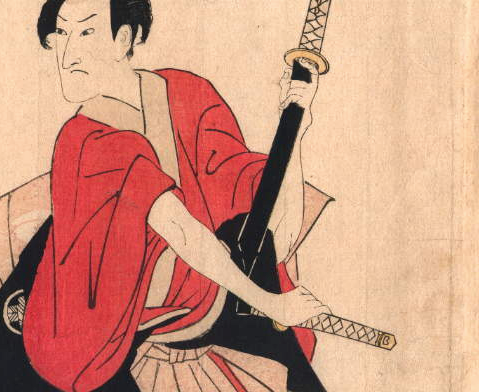-
Posts
380 -
Joined
-
Last visited
-
Days Won
1
Everything posted by FlorianB
-
Is the shiny surface a plating? The inner sides of the sukashi look like another material iron or oxidized copper.
-
Won't be a drag, but it looks not original Japanese to me…
-
Steve, have You tried shippō 七宝? The design is identical (?) with itomaki, but means "7 treasures of Buddhism".
-
Oops, I haven't, I just replied to the Higo notion above. There are Ito-maki on Higo-Tsuba to be seen, but I know only examples without ji-sukashi: A cloud- or snow-design selection from Higo will show the obvious difference of execution to the one in question: After all - not Higo.
-
Obviously the design (itomaki consisting out of snow/clouds/mist) is based on the Akasaka-style, but the ko-niku mimi and the somewhat clumsy seppa-dai speak against this school. Higo would be more exactly in execution. I suppose an unknown minor workshop trying to copy the mentioned style.
-
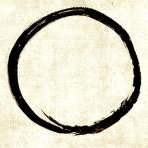
Extra large single Menuki, school and where to mount
FlorianB replied to Jack Zacao's topic in Tosogu
It mustn’t be a menuki necessarily. Large, single ornaments like yours could have been made for tobacco pouches like these sold at Bonham’s: -
Found this print, the hangers are obviously wooden rattles here. Florian
-
A rural scene is depicted: on the front paddy farmers with their typical straw hats are planting rice. On the backside we see a thin pole with four strings (maybe a reduces number is shown?) on which several hangers are attached. These hangers are obviously floating in the wind. IMHO this construction should simply drive off birds from the fields. Best, Florian
-
Sorry to reanimate an old thread, but this wonderful table caught my eye and matches in here: This display contains Tsuba of the Halberstadt collection in the Design Museum in Copenhagen, Denmark https://designmuseum...n/press-room-wonder/ Best, Florian
-
Hello Michael, I’m primary an iron guy, however a good starter collection - congrats! Most of those seem to be from late Edo-times, the last one with the insects maybe Meiji, but I’m not an expert. The surface of the one with „cock and bamboo“ seems to have a bluish look, maybe fire damage? But difficult to determine by the pictures alone. There are clouds of red rust which should be removed with deer antler or bones as soon as possible. Best, Florian
-
Very funny, never saw such before. Seems a collector piece, not for real use. Also nice the scene on the back. People eat obviously onions - to take part in the competition? The costumes suggest an early period, but of course the Kozuka was made around late Edo. Any idea about the signature? Best, Florian
-
-
I appreciate the enthusiasm in this topic. However, what we read here are laments about and proofs for the erroneous classification system. BTW criticism which isn’t new at all and popped up from time to time. The topic is labelled „ideas that need to change“, but with all respect we read nothing about attempts or even any suggestions for a revision of the classification. Instead the discussion gets lost in details, which better should be discussed separatly. It’ s easy to tear down the walls but there must arise something new, a heap of ruins will satisfy no one. If in the past attempts have been made (and I do believe so) to establish a new system these efforts apparently failed. And as long as no alternatives will exist I’m afraid we will stick to the old classification furthermore: „We know it’s not good, but it’s the only one we have!“ Florian
-
Concerning the timeline I waited for this Tsuba with controversial dating to pop up but now I yield it by myself: It is owned by the Museum of Fine Art in Boston and according to Okabe Kakuya who wrote the first museum catalog in 1908 it is a Momoyama piece. Okabe interpreted the combination of gourd and kiri as a hint to Toyotomi Hideyoshi and the background pattern of snowflakes is said to have been a popular fabric design at this time, too. I think even today the museum refers to this dating (see also „Lethal Elegance“ by Joe Earle). The very same Tsuba is depicted in Sasano’s TOSOGU NO KIGEN (1979). He focused on the peculiar form of the hitsu-ana. In the named book he sums up the development of Kogai and Kozuka pointing out that the early ones have a flat design while later with the Goto-lineage more and more relief-like decoration appeared. This makes it necessary to change the form of the hitsu-ana to larger, rounded ones. In correspondence with other examples showing similar primary hitsu-ana he dates it back to the Nambokucho period. About 200 years difference! There are others who dated it in between those periods and I don’t think there will be ever an ultimate answer. But why I mentioned this Tsuba is that the age estimation is based on one hand on the design, on the other hand on a technical background. Best, Florian
-
Sorry to correct the "jumping carp": It's a KOINOBORI, a windsack in form of a carp used as an auspicious symbol on boy's day on May 5th. An UKIYO-E by Hiroshige (maybe the model for the TSUBA in question?): Best, Florian
-
I want to clarify my objection concerning the demand for historical illustrations. Edo-period illustrations (excluding pattern books of course) depict hardly any individual Tsuba-Design although we know many different models were in use. But this obviously means nothing. llustrations from Muromachi-times depict also no individual Tsuba-Design - but this shall proof their non-existence. I can only speculate why Tsuba patterns have been omitted by the artists through the times, but at least the illustrations cannot (or only in some cases) consulted to back up the development of Tsuba. Florian
-
Thomas, in some way You are right, it’s the same old story of supply and demand. There was a time, I also thought gaining a papered piece is the top of bliss. But someday I had the opportunity to buy something and asked if it is papered. The seller asked me in return, if I do collect papers? At this point I became grounded and I possess many pieces today without paper. Nice to have them, but it is more important to recognize the quality of a piece itself. Alas, many folks are still blended by papers or even worse demand them to be sure. BTW: The limitations at the shinsa is a result of missing judges, too. I think if they had enough board members, they could manage the flood of submissions as well… Florian
-
Besides the attribution: In my younger collector days (decades ago) a Hozon-paper was something special and proofed a certain grade. But today Tsuba from top to low End got Hozon so it became an inflationary practice and says nothing about quality at least. IMHO these papers will loose more and more significance (as the former Kicho-Papers have). If there will be maybe a revision of the certification system it can only be build up on levels of quality to become reliable again. Florian
-
Glen, the shots are just a random selection (just a fast search) of woodcut prints found in the web, but endless others could be added. I choose especially prints of the Edo-times and also scenes of this time, so decorated Tsuba must have been common. Thus it is peculiar artists don’t depict them (the suggested reason I gave above). Florian
-
The illustrations of Tsuba on paintings (scrolls and screens) and woodblock prints are not a reliable source. In most cases plain round or mokko-shaped swordguards WITHOUT ANY decoration (neither sukashi nor kinko - and by the way without hitsu-ana!) are shown. Does it means that samurai didn’t use decorated Tsuba? Certainly not, but the depiction of small details was apparently technical difficult or the artist wasn’t interested in an exact depiction and a simplified, standardized type was sufficient for him. Florian
-
Gentlemen, I want You to remember that Mr. Haynes is a well reputed and skilled collector so there is no need for mockery. Don’t forget he went for Tsuba when most of us haven’t been born and without todays possibilities. There are indeed pieces I won’t agree with Mr. Haynes judgement, but this can be discussed without scoffing. Florian
-
Mostly we are looking for a definitive, and thus satisfying explanation, in this particular case a Tsuba motif. But there are Japanese design motives which are intentionally unclear and could be interpreted in different ways. So everything You will see in it is correct! Maybe an artist created a Tsuba without the purpose to depict something. He has had just fun by playing with forms or varying existing ones. In these cases just enjoy the result and admire the beauty of shapes and surface. And the little secret not exactly to know what it means keeps it more interesting. Florian
-
Hi Steve, the wavy lines in the circle merge in a curve into the outer rim and connect these parts to one form. So I would clearly support Your sea cumber interpretation. Similar examples with angular connections at the junction seem far more indifferent. In the "Tosogu Classroom" Vol. 1 the motif is assumed as "OI" or backpack box for Yamabushi. So it’s a nice example how a little variation of curvature changes a design. However, a wonderful find! Congrats! Florian
-

Skulls, bones, and grave markers—An interesting tsuba
FlorianB replied to brentlewiis's topic in Tosogu
Seeing the front I wasn't sure what to make out of it, but the backside looks all right. I’ve never seen such before - interesting indeed! Is the front side plated? Florian






